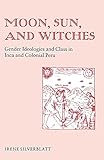Moon, Sun, and Witches : Gender Ideologies and Class in Inca and Colonial Peru / Irene Marsha Silverblatt.
Material type: TextPublisher: Princeton, NJ : Princeton University Press, [2021]Copyright date: ©1987Description: 1 online resource (304 p.)Content type:
TextPublisher: Princeton, NJ : Princeton University Press, [2021]Copyright date: ©1987Description: 1 online resource (304 p.)Content type: - 9781400843343
- Inca women
- Incas -- Social life and customs
- Indian women -- Peru
- Indians of South America -- Peru -- Social life and customs
- Social structure -- Peru -- History
- Women -- Peru -- History
- SOCIAL SCIENCE / Women's Studies
- Achikee
- Acomayo (province)
- Antisuyo
- Apurima
- Azangaro
- Caina (village)
- Cajatambo (province)
- Capac Inti raymi
- Capac Yupanqui
- Choqueruntu
- Cocamama
- Delgado, Juan
- Dias, Isidora
- Flores, Carlos
- Francisca, María
- Gorgor (village)
- Gualparoca
- Guamancama
- Guarco
- Huamantanga (village)
- Huarcos
- Huascar
- Huaylla
- Intiillapa
- Juana Agustina
- Kramer, Heinrich
- Llacxamisa
- Lluqui Yupanqui
- Lord Earth
- Mama Carhua
- Marxism
- Nariguala
- Oberem, Udo
- Otuco (village)
- Pachacuti Inca
- Pachamama
- Pariahirca (mountain)
- Pauquirbuxi
- Quilla raymi
- Raupoma
- Sañumama
- Tanta Carhua
- Tarquiurau
- atriguasara
- bride price
- capacocha
- chronicles
- encomenderos
- gods, in ayllus
- haciendas
- machayes
- mascaypacha
- midwives
- prostitution
- 985 .01 088042 19
- F3429.3.S6
- online - DeGruyter
| Item type | Current library | Call number | URL | Status | Notes | Barcode | |
|---|---|---|---|---|---|---|---|
 eBook
eBook
|
Biblioteca "Angelicum" Pont. Univ. S.Tommaso d'Aquino Nuvola online | online - DeGruyter (Browse shelf(Opens below)) | Online access | Not for loan (Accesso limitato) | Accesso per gli utenti autorizzati / Access for authorized users | (dgr)9781400843343 |
Frontmatter -- CONTENTS -- List of Figures -- Acknowledgments -- Introduction -- Chronology -- I. PRODUCING ANDEAN EXISTENCE -- II. GENDER PARALLELISM IN LOCAL COMMUNITIES -- III. GENDER PARALLELISM IN THE IMPERIAL ORDER -- IV. IDEOLOGIES OF CONQUEST IN THE AYLLU -- V. TRANSFORMATIONS: THE CONQUEST HIERARCHY AND IMPERIAL RULE -- VI. UNDER THE SPANISH: NATIVE NOBLEWOMEN ENTER THE MARKET ECONOMY -- VII. WOMEN OF THE PEASANTRY -- VIII. POLITICAL DISFRANCHISEMENT -- IX. CULTURAL DEFIANCE: THE SORCERY WEAPON -- X. WOMEN OF THE PUNA -- XI. A PROPOSAL -- Appendix: Ayllu, Tributed Ayllu, and Gender -- Glossary -- A Note on Sources -- Bibliography -- Index
restricted access online access with authorization star
http://purl.org/coar/access_right/c_16ec
When the Spanish arrived in Peru in 1532, men of the Inca Umpireworshipped the Sun as Father and their dead kings as ancestor heroes,while women venerated the Moon and her daughters, the Incaqueens, as founders of female dynasties. In the pre-Inca period suchnotions of parallel descent were expressions of complementarity betweenmen and women. Examining the interplay between gender ideologiesand political hierarchy, Irene Silverblatt shows how Inca rulersused their Sun and Moon traditions as methods of controllingwomen and the Andean peoples the Incas conquered. She then exploresthe process by which the Spaniards employed European maleand female imageries to establish their own rule in Peru and to makenew inroads on the power of native women, particularly poor peasantwomen.Harassed economically and abused sexually, Andean womenfought back, earning in the process the Spaniards' condemnation as"witches." Fresh from the European witch hunts that damnedwomen for susceptibility to heresy and diabolic influence, Spanishclerics were predisposed to charge politically disruptive poor womenwith witchcraft. Silverblatt shows that these very accusationsprovided women with an ideology of rebellion and a method fordefending their culture.
Mode of access: Internet via World Wide Web.
In English.
Description based on online resource; title from PDF title page (publisher's Web site, viewed 30. Aug 2021)


